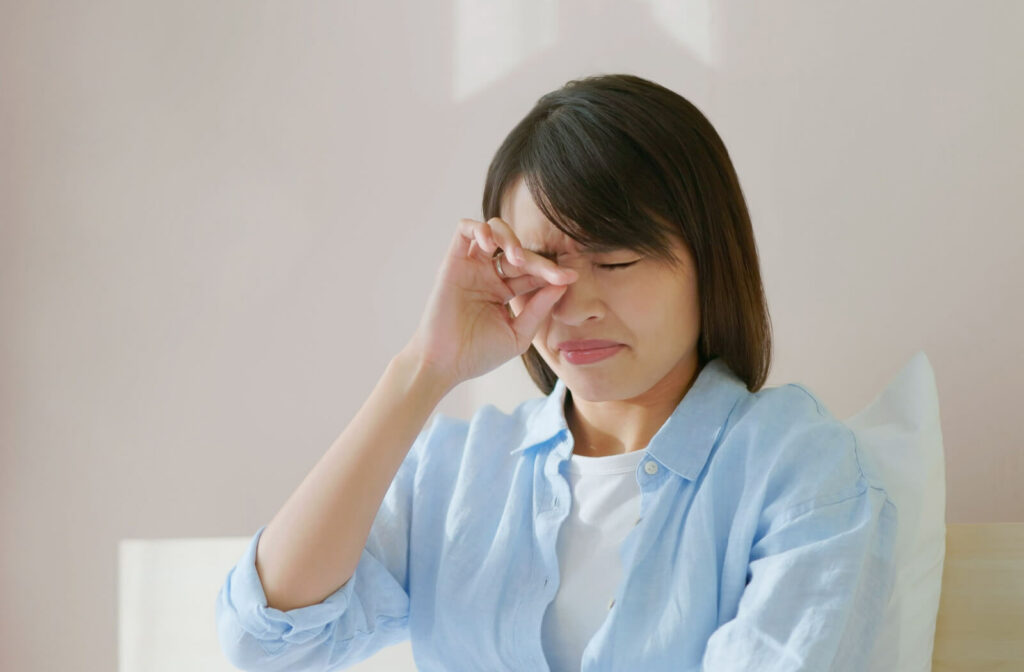Do You Eyes Get Dry with Contacts?
Contact lenses offer many benefits compared to glasses —they’re comfortable, convenient, and provide a more natural field of vision. However, sometimes, you may experience dry eye symptoms when wearing contacts, leading to discomfort, itching, and irritation.
You can manage dry eyes with contact lenses by:
- Using daily disposable contact lenses
- Changing your contact lens wear schedule
- Changing your contact lens solution
- Maintaining proper contact lens care
- Taking regular breaks from screen usage
- Try the new DigitalBoost™ lens design contact lenses
- Using rewetting drops
But before deciding to switch to a different contact lens, a contact lens exam and fitting can help determine the type of contact lens you should wear based on your needs and eye health.
What Is Dry Eye?
Dry eye occurs when your eyes can’t produce enough tears or your tears are of low quality. Tears are composed of water, oil, and mucin, which provide the eyes with lubrication, protection, and nutrients. An imbalance in the tear film can lead to dry eyes.
Symptoms of dry eye include:
- A scratchy or gritty sensation
- A stinging or burning feeling
- Irritation
- Discomfort
- Redness
- Light sensitivity
- Blurry vision
Risk factors for dry eye include:
- Age: The body produces fewer tears as you age.
- Hormones: Hormonal changes during pregnancy and menopause can affect tear production.
- Diet: A lack of vitamin A or omega-3 fatty acids can lead to fewer tears.
- Medical conditions: Certain autoimmune conditions can cause dry eye.
- Contact lenses: Wearing contact lenses for extended periods can increase your risk of dry eye.
- Prolonged screen time: using screen-based devices decreases the amount of times you blink, leading to partial blinking and increased tear evaporation.
Contact Lenses & Dry Eye
Contact lenses can affect your eye health and lead to dry eye in several ways:
- Irritation or abrasion: Caused by lens materials, inappropriate design, or improper fitting.
- Foreign body interaction: Contact lenses may interact with dust or other foreign debris, leading to irritation.
- Reduced oxygen levels: Prolonged wear of contact lenses can result in decreased oxygen levels, contributing to dry eyes.
- Extended wear times: Longer durations of contact lens use may exacerbate dry eye symptoms.
- Infection or chemical exposure: Risk of infection or exposure to chemicals from preservatives in contact lens care solutions.
- Contact lens intolerance: Some people may experience issues with contact lenses.
- Environmental factors: Low humidity or high airflow conditions while wearing contact lenses can contribute to dry eyes.
Ways to Manage Dry Eye When Wearing Contact Lenses
If you’re unsure about your symptoms, visit your eye doctor to determine the underlying cause and recommend ways to relieve your dry eyes when wearing contact lenses. Managing dry eyes can be multi-faceted, including hydration, lens material, lens care, and lifestyle changes.
Hydration
Preservative-free lubricating or rewetting eye drops can help replenish moisture, relieve dryness, and reduce the friction between the lens and your eye. Speak to your eye doctor about which drops are compatible with your specific type of contact lenses.
Contact Lens Material
Opt for quality, breathable contact lenses that allow more oxygen to reach your eyes. Silicone hydrogel lenses are a fantastic choice as they offer enhanced breathability and reduce the likelihood of dry eyes.
Your eye doctor will conduct a comprehensive eye exam and a contact lens exam to determine the right contact lenses for your eyes, lifestyle, eye health, and prescription.
Contact Lens Wear Schedule
Make sure you follow the suggested replacement schedule. Wearing contact lenses for too long can lead to gunk buildup and less oxygen getting through, making your eyes even drier.
Consider switching to daily disposables or a replacement schedule your eye doctor suggests to keep things in check.
Lifestyle Habits
It may sound simple, but frequent blinking can help distribute tears evenly across your eyes, preventing dry eyes. Remind yourself to blink consciously, especially during extended screen time.
If you spend a lot of time on digital devices, follow the 20-20-20 rule. Every 20 minutes, take a 20-second break and look at something 20 feet away. This rule can help digital eye strain its related symptoms and encourage natural blinking.
Proper Contact Lens Care
Your contact lenses will need a specific care routine based on the type you wear:
- Wash your hands with soap and water and dry them thoroughly before touching your lenses.
- Don’t use water to rinse or store your contact lenses. Only use a contact lens solution designed for your lens type.
- Store contact lenses in a lens case and replace it every 3 months—contact lens solution needs to be replaced daily.
- Switch your lens solution if you experience irritation, as your eyes may not agree with the preservatives.
Environment
Low humidity indoors can make your eyes feel dry, especially if you wear contact lenses. Consider using a humidifier in your living or workspace to keep things humid, especially in the winter when the heaters are cranked up. If you’re heading outside, toss on some wraparound sunglasses to protect your eyes against the elements like wind, dust, and tears evaporating.
Personalized Solutions for Dry Eyes
Don’t let dry eyes prevent you from wearing contact lenses. You can experience comfortable vision with contact lenses by incorporating simple ways to manage your dry eyes.
If your dry eyes persist, book an appointment with the eye doctors at Eye Lab. We can recommend personalized solutions, such as specific types of lubricating drops or alternative contact lens options.




